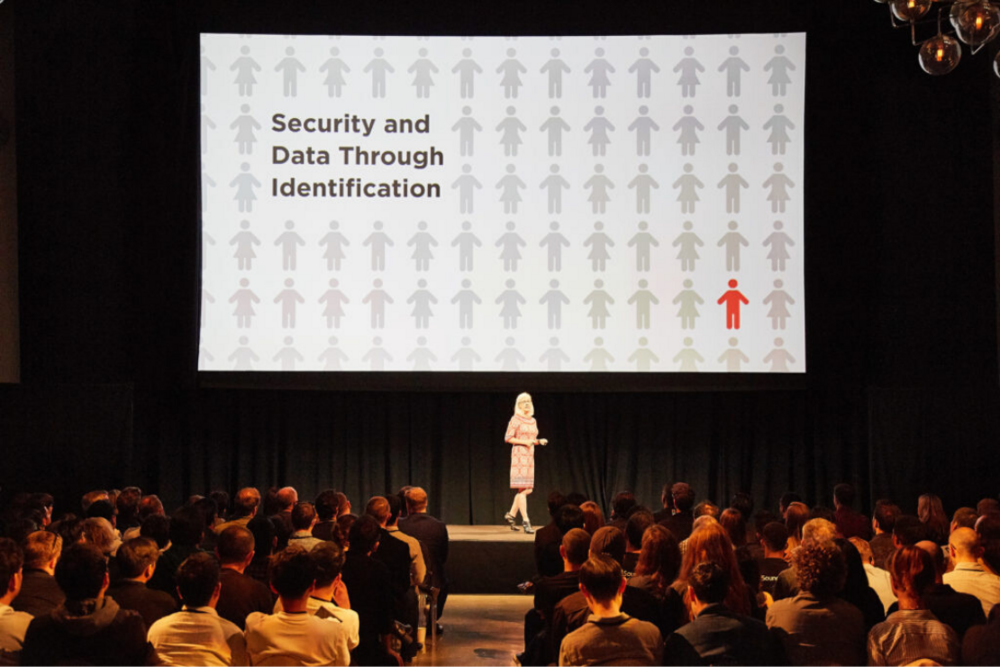Teaching a VC How To See: Tips for Women Entrepreneurs
Apr 11, 2019

4-min read
We talked with Mary Haskett, founder and CEO of Blink Identity (Techstars Music 2018), about how women entrepreneurs can be fully seen and respected by potential investors. This involves recognizing patterns, getting assistance from your team, and making the pattern work to your benefit.
Mary Haskett, founder and CEO of Blink Identity, had a problem. Time after time, she and her cofounder, Alex Kilpatrick, would walk into an important meeting — often with a potential investor — and Alex, a man, would get the handshake.
People looked at the two of them and assumed he was the CEO and she was from the marketing department. Mary would quickly settle the misunderstanding, but everyone ended up embarrassed, and she often felt angry. It was a bad way to start a meeting, let alone a new working relationship.
Finding the Pattern
So Mary started looking for a solution. After all, she’s an expert in machine learning and pattern recognition. The Blink Identity security gateway uses facial biometrics to identify people. She has literally taught a computer how to see faces and correctly identify them. How could she teach the busy people she was meeting with to correctly identify her as the CEO?
“I started to frame it in terms of pattern recognition,” Mary said. “That VC probably doesn’t hate women. Or at least, that’s not a useful assumption.” The VC, rather, is busy, and sees what he expects to see (91% of the decision makers at U.S. venture capital firms are men).
When there’s too much data coming in, pattern recognition makes sense of it all. Figuring out how to teach machines how to do this is hard work, but people do it all the time. We have to do it. There’s always too much data: the world, in all its multitudinous splendor, is too much data.
That busy VC has met with thousands of entrepreneurs, and most of them have been men (though this is slowly changing, but has historically been the case). He’s probably meeting with a long string of entrepreneurs just today. So when a man and a woman walk in, he assumes that the pattern will hold true, and he holds out his hand to the man.
It Takes Teamwork
Once Mary thought about the problem this way, she let go of her anger around it. “It’s wrong, but it’s not personal,” she said. “And once I realized that it wasn’t personal—that the VC wasn’t slighting me personally—I started coming up with strategies to change the data, change the pattern.”
Today, when Mary and Alex walk into a room, she goes in first, and he enters a beat behind her. By then, she’s already got her hand out. They intentionally code their clothing: business clothes for her, company t-shirt and jeans for him. Also, if there’s anything at all to be carried into the room, Alex is carrying it. This subtly reinforces that Mary is in charge, plus it keeps her hands free for the shake.
Just like that, Mary is the CEO, and everyone knows it.
Mary and Alex have also come up with a technique for questions that are asked to the room at large, or even directly to Alex, but that Mary, as CEO, should be answering. Even though Alex may know the answer perfectly well—he’s the CTO, after all—he stays silent. Mary answers.
Of course, this takes real teamwork. “Alex has to be a partner in this,” Mary said. “He could undermine me very easily. Instead, he and I brainstorm solutions together.” It helps that these two are old friends, but any co-founders can do this—if they’re willing to work together and support each other.

Make the Pattern Work For You
In the man-filled world of entrepreneurship, Mary stands out just by being a woman. She breaks the pattern. Depending on the situation, she may do her best to minimize this, or to make it work for her.
“I did a lot of work for the Department of Defense.” Mary said. “They all wear suits, they all have a certain way of being. You either have to match it so they don’t even see that you’re a woman, or break it so strongly that they really have to see you.” At the DoD, Mary chose to go with the pattern, doing her best to blend into the rigid expectations so that she would be taken seriously.
In the startup world, Mary often goes in the other direction. As a woman, she already breaks the pattern, so she doubled down on this strategy in order to stand out and be more than just another in the day’s string of meetings.
She met a lot of investors during the Techstars Music Accelerator, but she wasn’t looking for funding yet. She was still working on customer discovery and knew it was important to get this right first. What she wanted was to ask the investors questions. “For someone who’s used to being asked for money, asking them questions instead broke the pattern,” Mary said. “By breaking the pattern, I got VCs to really see me.”
Mary also calms herself in investor meetings by breaking her own patterns of thinking. “I remind myself: they’re looking for a good investment. They’re not all powerful people to do a song and dance for.” Instead, she tries to think of VCs as coworkers. “We’re equals, peers, and each of us has different things we’re bringing to the table. I’ve got the idea, the tech, plenty on my side.”
Not that this makes the process easy: “Plenty of times my knees are shaking, but I do it anyway,” Mary said.
For Mary, this approach to investor meetings also helped her find investors who were truly looking to partner with Blink Identity and build a lasting relationship. A few months after the end of the accelerator program, Blink Identity raised a $1.5 million seed round.
How Do You Want To Be Seen?
We all should be doing the important work of finding our implicit biases and evaluating how they impact our behavior. (A man and a woman walk into a meeting. Whose hand do you shake first?)
But Mary’s lens of pattern recognition offers a tool for dealing with the world as it is, where we all have to cope with bias. This doesn’t remove anyone else’s responsibility to manage their bias, but it does offer some measure of control on your end.
The next time you’re heading into an important meeting, think about the pattern recognition going on in the people you’re about to meet. And ask yourself what you can do to help yourself be seen the way you want to be seen.
